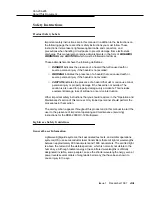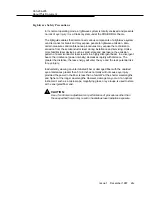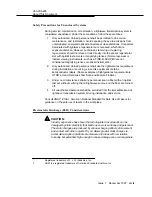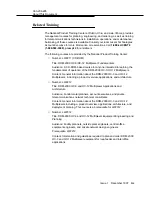
363-206-295
About This Document
xliv
Issue 1
December 1997
Conventional lasers can produce an intense beam of monochromatic light. The
term monochromaticity means a single wavelength output of pure color that may
be visible or invisible to the eye. A conventional laser produces a small-size beam
of light, and because the beam size is small the power density (also called
irradiance) is very high. Consequently, lasers and laser products are subject to
federal and applicable state regulations as well as international standards for their
safe operation.
A conventional laser beam expands very little over distance or is said to be very
well collimated. Thus, conventional laser irradiance remains relatively constant
over distance. However, lasers used in lightwave systems have a large beam
divergence, typically 10 to 20 degrees. Here, irradiance obeys the inverse square
law (doubling the distance reduces the irradiance by a factor of 4) and rapidly
decreases over distance.
Lasers and Eye Damage
Light energy emitted by laser and high-radiance LEDs in the 400-1400nm range
may cause eye damage if absorbed by the retina. When a beam of light enters the
eye, the eye magnifies and focuses the energy, magnifying the irradiance. The
irradiance of energy that reaches the retina is approximately 10
5
or100,000 times
that at the cornea; and if sufficiently intense, may cause a retinal burn.
The damage mechanism at the wavelengths used in telecommunications is
thermal in origin (that is, damage caused by heating). Therefore, a specific
amount of energy is required for a definite time to heat an area of retinal tissue.
Damage is not instantaneous. It occurs only when one looks at the light
sufficiently long that the product of the retinal irradiance and the viewing time
exceeds the damage threshold. Light energies above 1400 nm would cause
surface and skin burns and do not affect the retinal area.
Classification of Lasers
Manufacturers of lasers and laser products in the U.S. are regulated by the Food
and Drug Administration's Center for Devices and Radiological Health (FDA/
CDRH) under 21 CFR 1040. These regulations require manufacturers to certify
each laser or laser product as belonging to one of four major Classes — Class I,
II, IIa, IIIa, IIIb, or IV. Lasers are classified according to the accessibly emission
limits and their potential for causing injury. Lightwave systems are generally
classified as Class I, because, under normal operation conditions, all energized
laser transmitting circuit packs are terminated on optical fibers which enclose the
laser energy with fiber sheath, forming a protective housing. Also, covers are in
place over the circuit pack shelves.
















































